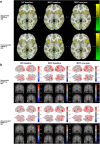This is a preprint.
Impact of year-long cannabis use for medical symptoms on brain activation during cognitive processes
- PMID: 38746368
- PMCID: PMC11092687
- DOI: 10.1101/2024.04.29.24306516
Impact of year-long cannabis use for medical symptoms on brain activation during cognitive processes
Update in
-
Year-Long Cannabis Use for Medical Symptoms and Brain Activation During Cognitive Processes.JAMA Netw Open. 2024 Sep 3;7(9):e2434354. doi: 10.1001/jamanetworkopen.2024.34354. JAMA Netw Open. 2024. PMID: 39292455 Free PMC article.
Abstract
Importance: Cannabis is increasingly being used to treat medical symptoms, but the effects of cannabis use on brain function in those using cannabis for these symptoms is not known.
Objective: To test whether brain activation during working memory, reward, and inhibitory control tasks, areas of cognition impacted by cannabis, showed increases following one year of cannabis use for medical symptoms.
Design: This observational cohort study took place from July 2017 to July 2020 and is reported on in 2024.
Setting: Participants were from the greater Boston area.
Participants: Participants were recruited as part of a clinical trial based on seeking medical cannabis cards for anxiety, depression, pain, or sleep disorders, and were between 18 and 65 years. Exclusion criteria were daily cannabis use and cannabis use disorder at baseline.
Main outcomes and measures: Outcomes were whole brain functional activation during tasks involving working memory, reward and inhibitory control at baseline and after one year of cannabis use.
Results: Imaging was collected in participants before and one year after obtaining medical cannabis cards; 57 at baseline (38 female [66.7%]; mean [SD] age, 38.0 [14.6] years) at baseline, and 54 at one-year (37 female [68.5%]; mean [SD] age, 38.7 [14.3] years). Imaging was also collected in 32 healthy control participants (22 female [68.8%]; mean [SD] age, 33.8 [11.8] years) at baseline. In all groups and at both time points, functional imaging revealed canonical activations of the probed cognitive processes. No statistically significant difference in brain activation between the two timepoints (baseline and one-year) in those with medical cannabis cards and no association of changes in cannabis use frequency with brain activation were found.
Conclusions and relevance: Findings suggest that adults do not show significant neural effects in the areas of cognition of working memory, reward, and inhibitory control after one year of cannabis use for medical symptoms. The results warrant further studies that probe effects of cannabis at higher doses, with greater frequency, in younger age groups, and with larger, more diverse cohorts.
Trial registration: NCT03224468, https://clinicaltrials.gov/.
Conflict of interest statement
Conflict of Interest Disclosures: AEE has served as a consultant to Charles River Analytics (NIDA SBIR grant) and Karuna Pharmaceuticals (Chair Data Monitoring Board). Other investigators report no potential conflicts.
Figures



References
Publication types
Associated data
Grants and funding
LinkOut - more resources
Full Text Sources
Medical
